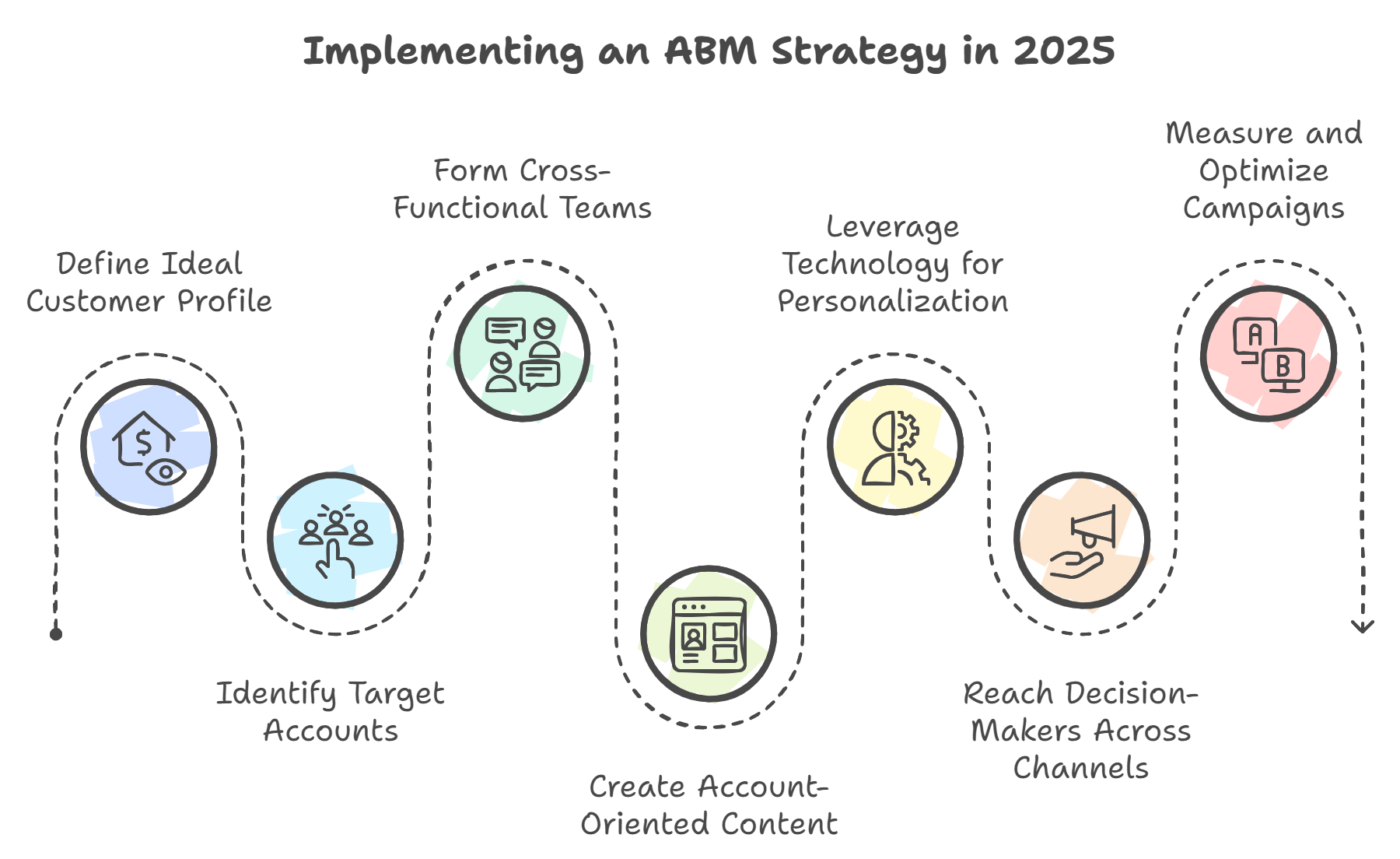How is account-based marketing a focused approach to B2B marketing in 2025?

With Account-Based Marketing, B2B marketing is taken to a new level. What has emerged here is the game-changer in how accounts are identified, engaged, and nurtured. Unlike other marketing approaches, ABM targets high-value accounts with all the precision and personalization. As we plunge into 2025, the increasing requirement of efficiency and effectiveness in B2B marketing has made ABM a sharp strategy, aligning marketing efforts directly with sales goals. To find answers on how ABM works, its benefits, and the actionable steps for the effective functioning of this approach, read more.
What Is Account-Based Marketing (ABM)?
ABM is a highly targeted marketing strategy where businesses treat individual accounts or groups of accounts as distinct markets. The essence of ABM is to target specific companies that fit in with a company's ideal customer profile (ICP). This involves providing personalized marketing and sales experiences to engage the decision-makers within these target accounts.
In 2025, leaps in technology, data analytics, and automation make ABM even more potent. Together with a human-centered approach, businesses can provide content to prospects that is more hyper-personalized. This leads to deeper relationships and higher ROI.
Why Is ABM a Focused Approach to B2B Marketing?

- Precision Targeting: ABM empowers businesses to identify and prioritize high-value accounts. Marketers can pinpoint the accounts that have a probability of conversion through intent data platforms and AI-driven insight, meaning that resources will now be pointed at places from where they would yield the greatest impact.
- Personalization at Scale: ABM is always centered on the personalized touch. Tailor content and messaging and create campaigns based on specific accounts in order to address unique challenges and goals for every target. This focused attention drives engagement and fosters trust.
- Alignment Between Marketing and Sales: ABM breaks down silos between marketing and sales teams. Both departments collaborate to identify target accounts, develop strategies, and execute campaigns, ensuring consistency in messaging and a seamless buyer journey.
- Efficient Resource Utilization: Traditional marketing often wastes resources on low-quality leads. ABM eliminates this inefficiency by concentrating on a smaller, high-potential audience, optimizing both time and budget.
- Enhanced Customer Experience: Target accounts' decision-makers like content and solutions, if they are relevant to them. The account-based approach delivers relevance and engagement at a deeper level, which tends to result in stronger relationships and loyalty.
How to Implement an ABM Strategy in 2025

- Define Your Ideal Customer Profile (ICP): Start with a clear profile of companies most likely to benefit from your product or service. Consider industry, company size, revenue, geographic location, and pain points already affected. CRM systems and data analytics platforms can help to refine your ICP.
- Identify Target Accounts: Apply intent data, market research, and sales insights to find the accounts that fit your ICP. Some of the most powerful tools for this purpose include LinkedIn Sales Navigator, ZoomInfo, and Demandbase.
- Form Cross-Functional Teams: Ensure that marketing teams are aligned with sales teams. Both teams should be aligned on the definition of goals, personalization of plans, and execution of campaigns tailored for each and every account.
- Create Account-Oriented Content: Develop unique content that resonates deeply with specific needs and pain points of target accounts. This may take the form of:
- Personalized emails
- Tailored case studies
- Whitepapers tailored by industry
- Tailored LinkedIn ads
- Leverage Technology for Personalization: In 2025, AI, machine learning, and marketing automation tools will be a must for achieving ABM success. Platforms like HubSpot, Marketo, and 6sense are helping marketers personalize at scale without losing that human touch.
- Reach Decision-Makers Across Channels: Use a multi-channel approach to reach your desired decision-makers within those target accounts. Popular channels are:
- Email marketing
- Social media, especially on LinkedIn
- Webinars and virtual events
- Personalized direct mail
- Paid ads targeting specific companies
- Measure and Optimize Campaigns: Monitor the performance of your ABM campaigns through metrics like engagement rate, account conversion rate, and deal velocity. Use analytics tool insights to refine the approach and improve results.
Case Studies: ABM in Action
- Technology Services Company: A firm offering technology solutions to enterprise customers applied ABM to its pursuit of Fortune 500 accounts. Video pitches and case studies made personal yielded a 40% deal size increase and reduced the sales cycle by 20%.
- SaaS Provider: A SaaS business leveraged intent data in a way to find companies that were actively researching their area. They saw a 50% increase in engagement rates and 3x return on investment from account-specific content and LinkedIn ads.
Obstacles and the Solutions of ABM for 2025
- Obstacle: Scalability
- Solution: Leverage AI and automation tools to scale personalized campaigns at a faster pace without sacrificing quality.
- Obstacle: Data Integration
- Solution: Invest in data management platforms that unify insights across marketing and sales.
- Challenge: Measuring ROI
- Solution: Implement robust tracking tools and align metrics with business objectives to clearly demonstrate the impact of ABM campaigns.
Why ABM Matters More Than Ever in 2025
The B2B marketing landscape in 2025 demands precision, relevance, and results. Buyers are inundated with generic messaging, making personalization the key to standing out. ABM not only addresses these demands but also ensures that marketing efforts are aligned with sales, driving better outcomes for businesses.
Such models of ABM allow companies, given increasing pressure to maximize ROI and streamline operations, to offer sustainable and scalable solutions. By focusing on quality over quantity, businesses can achieve meaningful engagement with key accounts, ultimately translating to long-term success.
Conclusion
Account-Based Marketing is not a trend; it's the future of B2B marketing. This ability to target the right accounts, deliver personalized experiences, and align sales and marketing efforts makes ABM a strategy that is quite strong for 2025 and beyond. Business houses can build robust relationships, register high conversion rates, and ensure sustainable growth in an increasingly competitive market through adoption of ABM.

